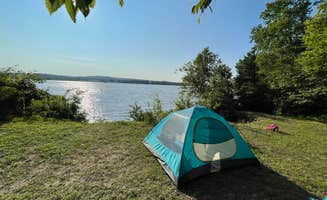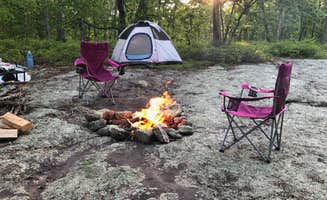Tent camping options near Sag Harbor, New York extend beyond the immediate shoreline, with several campgrounds accessible within a 1-2 hour drive radius. The Long Island region features a mix of coastal and inland camping environments, with sites typically open from April through October. Several campgrounds require boat access, providing more secluded experiences compared to mainland options.
What to do
Paddle to island campgrounds: Selden Neck State Park requires a 20-minute kayak or boat journey across the Connecticut River. The boat launch at Deep River Landing provides parking, though permits are required between Memorial Day and Labor Day. Selden Neck State Park Campground offers sites with picnic tables and fire pits. "At low tide, a couple of beaches emerge to play on," notes Jason S.
Explore riverside camping: River Highlands State Park provides campsites adjacent to the Connecticut River, approximately 90 minutes from Sag Harbor. River Highlands State Park River Campground offers scenic waterfront camping. Alicia B. reports, "The campsite was absolutely beautiful—especially with its location right by the river."
Visit local attractions: The historic Gillette Castle provides a cultural stop near camping areas in Connecticut. "Castle has tours at certain times," mentions Todd J., making it a worthwhile day trip from Gillette Castle State Park Campground.
What campers like
Beach proximity: Fire Island camping areas provide direct ocean access without driving to beaches. "You can get a permit to backcountry camp instead of reserving a designated campground spot. Just walk down to the beach after check-in and walk east until you see a pole with a tent symbol on it," advises Emily S. about Fire Island National Seashore.
Waterfront views: Many campers appreciate the waterfront locations throughout the region. "We have camped on the south end of Hurd Park several times via boat access. It is amazing with the views of the CT River and being able to watch the sunrise and sunset," shares Jackie G.
Natural soundscapes: The sound of waves provides nighttime ambiance at coastal sites. Igor K. describes Watch Hill as having "Birdsong in the morning and the sound of the waves," creating a natural sleep environment different from inland campgrounds.
What you should know
Insect preparation: Multiple campers emphasize the need for serious insect protection. "We couldn't even enjoy our meals at camp because it was that bad. Def bring a shelter or a canopy with a mosquito net!!!" warns Rosie R. about Watch Hill Fire Island Campground. Mosquitoes and horseflies are frequently mentioned as significant challenges.
Shower limitations: Beach campgrounds typically have basic facilities. Pedro R. notes, "Only thing no hot showers as it was a beach bathroom shower. It was a little cooler so showering was not that great also showers are not covered no curtains."
Transportation logistics: Most coastal camping requires ferry transportation and gear hauling. "It is a little less than a half mile walk from the ferry dock and located behind the dunes which offer some protection," explains Jill F. about Watch Hill, highlighting the need to plan for moving equipment from arrival points.
Wildlife encounters: Chapman Pond Preserve provides tent platforms with river views but comes with wildlife considerations. Ben L. describes it as a "Middle of nowhere site" with platforms, tables, and outhouses, while other riverside campgrounds report arachnids in facilities.
Tips for camping with families
Program availability: Some campgrounds offer structured activities for children. "There are park rangers on site and have excellent programs for kids," mentions Inocencia O. about Watch Hill, providing educational opportunities during family tent camping trips near Sag Harbor.
Alternative accommodations: For families not ready for full camping experiences, some locations offer hybrid options. "Not ready for full on camp-life? No problem! There are shops, a restaurant and a bar a 10 minute walk away!" suggests Inocencia O., making coastal camping more accessible for families with young children.
Site selection strategy: When camping with groups or families, coordinating site reservations enhances privacy. "There's a few sites close to each other, so it is nice to go with enough people to occupy them all at once to keep it personal," recommends Jackie G. about waterfront camping.
Tips for RVers
Limited RV options: Most camping near Sag Harbor focuses on tent camping with few dedicated RV facilities. Areas like Hidden Lake Farm accommodate small campers but offer minimal hookups, with only 5 sites available.
Seasonal timing: Off-season camping provides more isolation. "It felt like we had the entire beach to ourselves because there was no one else even close to around us, we went the weekend after labor day," notes Emily S., suggesting early September offers fewer crowds while maintaining moderate temperatures.
Equipment transport: RV campers should note that many island camping destinations require boat access, limiting vehicle use. Most coastal sites restrict RVs entirely, making tent camping the primary accommodation option in the immediate Sag Harbor vicinity.




